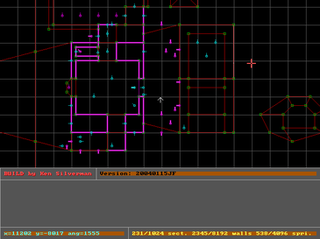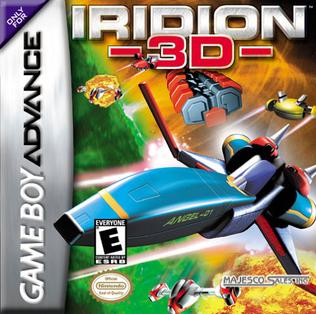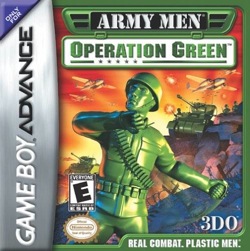
Duke Nukem 3D is a first-person shooter video game developed by 3D Realms. It is a sequel to the platform games Duke Nukem and Duke Nukem II, published by 3D Realms.

Duke Nukem Forever is a 2011 first-person shooter video game for Windows, OS X, PlayStation 3, and Xbox 360. It is a sequel to the 1996 game Duke Nukem 3D as part of the long-running Duke Nukem series. Duke Nukem Forever entered development in 1997 at 3D Realms and Triptych Games and was finished by Gearbox Software and Piranha Games in 2011.

Build is a first-person shooter engine created by Ken Silverman for 3D Realms. Like the Doom engine, the Build engine represents its world on a two-dimensional grid using closed 2D shapes called sectors, and uses simple flat objects called sprites to populate the world geometry with objects.

Ken's Labyrinth is a first-person shooter DOS game, released in 1993 by Ken Silverman through his Advanced Systems. It was fully coded by Ken Silverman, who later went on to design the Build engine that was used for rendering a first-person viewpoint in 3D Realms's Duke Nukem 3D (1996) and most recently in Ion Maiden (2018). It consists of three episodes, the first of which was released as shareware.
A first-person shooter engine is a video game engine specialized for simulating 3D environments for use in a first-person shooter video game. First-person refers to the view where the players see the world from the eyes of their characters. Shooter refers to games which revolve primarily around wielding firearms and killing other entities in the game world, either non-player characters or other players.

The Sum of All Fears is the name of two tactical shooter video games developed by Red Storm Entertainment and published by Ubi Soft; one was released for Microsoft Windows, PlayStation 2 and GameCube, based on the Ghost Recon game engine; the other was released for the Game Boy Advance.

Midnight Club: Street Racing is a racing arcade game, developed by Angel Studios and published by Rockstar Games. The game focuses on competitive street racing and the import scene. The game was released for the PlayStation 2 and Game Boy Advance platforms, the former being a launch title for the platform. It is the first game in Midnight Club franchise, followed by Midnight Club II.
Sunstorm Interactive is an Indianapolis-based video game developer founded in 1995 by Anthony Campiti, which specialized in hunting simulators and first-person shooters. The majority of their titles were small-scale "value titles", priced between $20 and $30 as compared to the typical computer game that was priced at $50 at the time.

Duke Nukem II: Escape From Alien Abductors! is a platform game developed by Apogee Software and released December 3, 1993. The game consists of four episodes, the first available as shareware. It is the follow-up to 1991's Duke Nukem, and followed by Duke Nukem 3D in 1996. Todd Replogle was the primary designer of all three games.

Ecks vs. Sever is a first-person shooter (FPS) video game for the Game Boy Advance handheld game console. It was developed by Crawfish Interactive. Based on an early script of the film Ballistic: Ecks vs. Sever, it is the first video game developed and released before the film it is based on had begun production. It is followed by the sequel Ballistic: Ecks vs. Sever, which having been released after the film, follows it more closely than the first game.

Duke Nukem: Land of the Babes is a third-person shooter video game in the Duke Nukem series of video games. This game is a direct sequel to the 1998 title Duke Nukem: Time to Kill.

Iridion 3D is a quasi-3D rail shooter video game developed by Shin'en. A launch title for the Game Boy Advance portable game console, it was released in North America on June 11, 2001 and in Europe on September 21 the same year. Influenced by the Commodore 64 game Uridium, the game features a single starship fighting the alien Iridion, who have attacked Earth. Iridion spans seven levels from Earth to the aliens' home planet, each with a fixed linear path that ends with a boss.

Lobotomy Software, Inc. was an American video game company responsible for the Sega Saturn ports of Quake and Duke Nukem 3D, and the original game PowerSlave.

Army Men: Operation Green is a top-down shooter video game developed by Pocket Studios and published by The 3DO Company exclusively for the Game Boy Advance. It was released in North America on December 2, 2001 and in Europe on March 15, 2002. It is part of the Army Men series of video games created by The 3DO Company, which is based on army men toys. It is the second game in the series for the Game Boy Advance, after the 2001 release, Army Men Advance.

Duke Nukem is a fictional character and protagonist of the Duke Nukem series of video games; the character is unrelated to the character of the same name from the TV series Captain Planet and the Planeteers, which was created a year prior. The character first appeared in the 1991 video game Duke Nukem, developed by Apogee Software. He has since starred in multiple sequels developed by 3D Realms. Most recently, he starred in Duke Nukem Forever, released by Gearbox Software, which now owns the rights and intellectual property.

Duke Nukem: Critical Mass is a shooter game developed by Frontline Studios and published by Deep Silver for the Nintendo DS. A version for the PlayStation Portable began development, however was never released.
The video game Duke Nukem Forever spent fifteen years in development, from 1996 to 2011. It is a first-person shooter for PC, PlayStation 3 and Xbox 360, developed by 3D Realms, Triptych Games, Gearbox Software and Piranha Games. It is a sequel to the 1996 game Duke Nukem 3D, as part of the long-running Duke Nukem video game series. Intended to be groundbreaking, Duke Nukem Forever has become infamous in the video games industry and was considered vaporware due to its severely protracted development schedule; the game had been in development under 3D Realms since 1996. Director George Broussard, one of the creators of the original Duke Nukem game, announced the development in April 1997, and promotional information for the game was released from 1997 until its release in 2011.


















